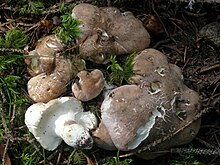| Albatrellus ovinus | |
|---|---|

| |
| Scientific classification | |
| Domain: | Eukaryota |
| Kingdom: | Fungi |
| Division: | Basidiomycota |
| Class: | Agaricomycetes |
| Order: | Russulales |
| Family: | Albatrellaceae |
| Genus: | Albatrellus |
| Species: | A. ovinus |
| Binomial name | |
| Albatrellus ovinus (Schaeff.) Kotl. & Pouzar | |
| Synonyms | |
| |
| Albatrellus ovinus | |
|---|---|
| Pores on hymenium | |
| Cap is convex or flat | |
| Hymenium is decurrent | |
| Stipe is bare | |
| Spore print is white | |
| Ecology is mycorrhizal | |
| Edibility is edible | |
Albatrellus ovinus is a terrestrial fungus found in Europe and North America. Although commonly known as sheep polypore, this fungus is not phylogenetically related to Polyporales (shelf fungi).
It similar to A. subrubescens, from which it may be distinguished microscopically.
Description
The cap is 4–20 centimetres (1+1⁄2–8 in) wide, convex then flat or depressed, and white then tan or pinkish. The surface is dry and smooth but cracks with age. The whitish stalk is 2.5–10 cm (1–4 in) tall and 1–4 cm (3⁄8–1+5⁄8 in) wide, perhaps branching, with an equal or larger base. The spore print is white.
Similar species
The inedible, closely related and comparatively rare Albatrellus subrubescens has subtle color differences from A. ovinus, and the only spores of the former are amyloid.
Also similar are Albatrellus flettii, Jahnoporus hirtus, Scutiger ellisii, and S. pes-caprae.
Distribution and habitat
It is found in northern Europe and in North America. In the latter, it is found from the Pacific Northwest to Northern California, in addition to the Mountain states, the Great Lakes area, the Appalachians, and the Northeast.
Uses
The species may be edible if cooked, but is not recommended by some guides. It is sold commercially in Finland.
References
- ^ Davis, R. Michael; Sommer, Robert; Menge, John A. (2012). Field Guide to Mushrooms of Western North America. Berkeley: University of California Press. pp. 339–340. ISBN 978-0-520-95360-4. OCLC 797915861.
- ^ Audubon (2023). Mushrooms of North America. Knopf. p. 158. ISBN 978-0-593-31998-7.
- Hibbett DS, Pine EM, Langer E, Langer G, Donoghue MJ (1997). "Evolution of gilled mushrooms and puffballs inferred from ribosomal DNA sequences". Proceedings of the National Academy of Sciences of the United States of America. 94 (22): 12002–6. Bibcode:1997PNAS...9412002H. doi:10.1073/pnas.94.22.12002. PMC 23683. PMID 9342352.
- W. Julich, 1984: Die Nichtblatterpilze, Gallertpilze und Bauchpilze. Kleine Kryptogamenflora Band II Teil b/1
- J. Breitenbach, F. Kranzlin, 1986: Pilze der Schweiz, Band 2. Nichtblatterpilze.
- Phillips, Roger (2010). Mushrooms and Other Fungi of North America. Buffalo, NY: Firefly Books. p. 295. ISBN 978-1-55407-651-2.
- Pelkonen, Riina; Alfthan, Georg; Järvinen, Olli (2008). Element Concentrations in Wild Edible Mushrooms in Finland. Helsinki: Finnish Environment Institute. p. 32. ISBN 978-952-11-3153-0. Archived from the original on 2011-09-28. Retrieved 2009-02-20.
External links
 Media related to Albatrellus ovinus at Wikimedia Commons
Media related to Albatrellus ovinus at Wikimedia Commons
| Taxon identifiers | |
|---|---|
| Albatrellus ovinus |
|
| Boletus ovinus | |